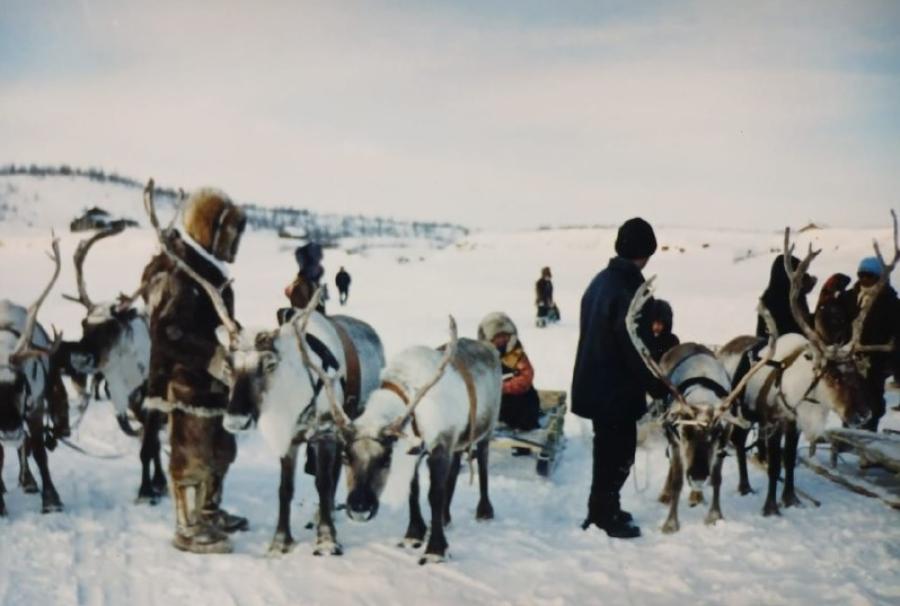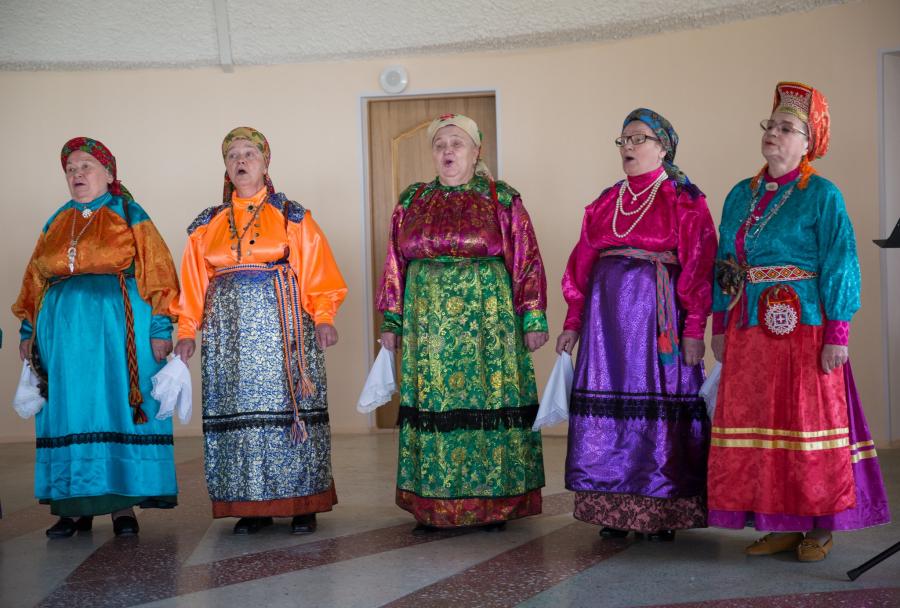In August 1991, we traveled to western Siberia to conduct a field seminar on visual anthropology in the village of Kazim. Our intention was to establish the practice of video ethnography among a small group of native Siberian cultural activists. Members of the Association for Ugrian Salvation, the regional native association, had shown an interest in using these techniques to extend the awareness of Khanty culture and encourage Khanty cultural preservation and revitalization in the context of their emergence from Soviet society. The seminar proved to be a practical way to enhance local participation in creating video and written ethnographic records for various research, archival, and educational purpose.
Our main objective was to invite a few young native men and women to make ethnographic video records of their own cultures. We assumed that a native record would differ from documentaries produced by Soviet or Western film makers. We expected that native video recorders would express a much higher degree of sensitivity to cultural meaning and relevant ethnographic detail than could an outsider.
Ten trained enrolled: six Khanty, two Nentsy, and two Yakut. Two Khanty women had some training in ethnography and worked in native cultural institutes. One Khanty woman works full-time in cultural institutes. One Khanty woman works full-time in cultural activities, and both Yakut men had considerable experience making films. One Nenets is an amateur video maker, while the other is a radio journalist. The other trainees were young Khanty hunters and reindeer drivers interested in video as a means of preserving traditional Khanty culture.
The seminar achieved three things. First, the native students gained an understanding of modern ethnographic field methods. Second, they learned about standard "observational cinema," a strategy of recording events live with minimal directional intervention. Finally, the students produced their own ethnographic records, on local subjects of their choice. All this, we hoped, would empower the indigenous activists in the future to record and represent their own cultures to the outside world.
The selection of topics proved to be critical ingredient in the training. Students were invited to list possible ethnographic subjects and and consult with members of the community to verify their importance. In fact, these videomakers did select some subjects outside the standard Western repertoire and approached them as insiders. They revealed meanings and details imperceptible to foreign observers. In matter little whether audiences elsewhere will appreciate the product: it is the indigenous point of view that is critical, and the seminar encouraged such expression.
THE VILLAGE OF KAZIM
Under the Czarust regime, three centuries of contact with Russian administrators, missionaries, and traders failed to alter the distinctiveness of native siberian culture, yet the recent history of the region has been one of profound change. In 1934, the Khanty rebelled against Soviet authority, but their revolt was crushed. Soon afterwards, native people were concentrated in seven cooperative villages; hunting and fishing were systematized, and reindeer breeding was greatly expanded. All children went to schools where Russian was the language of instruction. Tight administrative control intensified ideological pressure. In 1961, the present state farm was established, four collective villages were abandoned, and Kazim emerged as the population center for the area and the home of most administrative, educational, and economic activities. A multiethnic town of about 1,000 people. Kazim is now home to about 500 Khanty and smaller numbers of Komi. Nentsy, Ukrainians, and Russians, among others.
In 1991, these complex processes of change were directly reflected in a local settlement pattern consisting of four types of units. Most people live in Kazim, which is comprised mainly of salaried workers, retired pensioners, children at a boarding school, and many unemployed young people. Two smaller villages, Yuilsk and Numto, are almost entirely native, with a predominance of traditional subsistence activities. Thirteen reindeer-breeding bridges follow a nonmadic circuit.
Finally, native families and single people live in many isolated log cabins permanently or seasonally. Traditional lifestyle are best preserved in some of these dwellings, whose inhabitants live largely off the land, catch fish in river weirs and fish traps, hunt for furbearing animals and various birds, collect berries, and engage in small-scale reindeer breeding. Deep in the forest, elderly people carefully preserve collections of ritual objects, a testimony to the persistence of traditional religion. Several of these objects were used in a 1991 revival of the bear feast, which had been banned for decades. Many Khanty consider this event evidence of the persistence and resurrection of traditional culture and ideology.
Nevertheless, the twentieth century has produced often irreversible effects, and the Khanty have watched many distressing problems develop, For example, the construction of a pipeline has destroyed many reindeer pastures and led to the arrival of so many foreigners that the Khanty now consider Kazim village a Russian settlement. Second, the young bitterly resent the loss of the Khanty language: in 1990, two-thirds of first-grade pupils couldn't speak it. Third, many young Khanty women prefer to marry Slavs, with the hope of moving to a Southern town, and they reject sharing the life of a nomadic reindeer breeder. Alcohol abuse, unemployment, and poverty are also integral to this list.
The native intelligentsia, for the most part female teachers and doctors, is not indifferent to the plight of the people. They have founded the Association for Ugrian Salvation, with a complex program for political, economic, and cultural autonomy. This "Ugrian Renaissance" movement, inspired by a generally conservative ideology, advocate renewed land claims, parallel native administrative structures, a new settlement pattern of autonomous native communities, and a variety of traditional cultural activities. In this effervescent context, the association sponsored our seminar and did so with energy and determination. (The Institute of Anthropology and Ethnology of the Soviet Academy of Science co-sponsored the project, and we received a grant from the U.S. National Science Foundation.)
ETHNOGRAPHY AND IDEOLOGY
On the first day of the seminar, we distributed three camcorders and told the students, to shoot anything in the community. Those who had relatives in Kazim immediately went to film them, the other students selected street scenes. The only advice we gave at this point were a few suggestions about improving the ethnographic quality of the tapes.
During the following days, Asen Balikei lectured on anthropological field methods, drawing mostly on recent research in the Canadian North. We introduced the methods of participant observation, life histories, and genealogical research, drawing on translations from Anthropological Research by Pertti and Greta Pelto. The class also discussed methods related to studying settlement patterns, subsistence activities, and family styles.
The dichotomy between material and spiritual culture, typical of Soviet anthropological writings, provoked a lively debate. Most students, influenced by their Marxist training, initially held that material culture, as expressed in daily interactions in the family setting, should get priority over issues of norms and values.
Later, students considered institutions that might integrate essential aspects of native Siberian culture. In this respect, they immediately commented that the bear feast played a similar role in Siberia to the potlatch of North America, where essential aspects of economy, aesthetics, and social organization are fused on a complex ceremony. The students mentioned that an Estonian cameraman had made a 28-hour video recording of a 1991 bear feast.
Mark Badger continued the instruction with some basic rules of ethnographic film: the primacy of content, the exclusion of scenarios and professional actors, the need to record activities fully, the avoidance of heavy-handed direction, the connection between visual and written records, and, above all, the need for research before shooting. But only in stage two of the seminar did we provide detailed instruction of ethnographic video techniques, explaining basic strategies of recording. This involved teaching about such things as medium shots and close-ups, panning, angles, framing, lighting, sound, zooming, and editing. During this process, groups of three students each worked on short programs, and the class critiqued the exercises.
At the beginning of the seminar, we talked with representative of the association about the subjects students would film for final projects. Although the students would select their own subjects, a preliminary list of possibilities might help them make the choice. The list developed with the association stressed traditional activities - bead work, the making of a drug-out canoe, traditional music, bow-and-arrow hunting, and so on. We presented this list to the students, reminding them that the cameras were for ethnography only, leading to video archives illustrating native culture. And we instructed them to avoid political themes, subjects that might encourage hatred or discrimination. A lively debate ensured, as some students spoke passionately about the problems plaguing native communities: the loss of native language and traditions, the encroachment of the oil industry, the destruction of the environment, the alienation created by the boarding school. When our people are dying and our cultures disappearing, they asked, why should we restrict ourselves to filming old ladies doing bead work?
The debate was exacerbated by a screening of "Chronicle of Sireniki," a profile of a Yupik (Eskimo) settlement on the Bering Straits, produced in 1990 with the collaboration of Balikci. Some students admired the film and considered it a fair representation of conditions in native Siberia. Others, including association representatives, rejected the film and criticized its pessimism and melancholy mood. Still others considered the film anti-Soviet propaganda.
In the midst of this discussion, we announced that high-quality student tapes might be screened in native communities in Alaska, Canada, and Greenland. Suddenly the students realized the potential impact of their productions. Classroom discussions took on even sharper ideological and political process, not just passive recorders of the past.
At this point, the students presented their preliminary subjects for final programs. The topics all fell within a general framework: 1) production should be inspired by the ideology of native renaissance, 2) the themes could cover the isolated dwellings as well as the multiethnic village of Kazim. 3) the programs should describe real life. With few exceptions, the students wanted to make an ideological statement about traditional Khanty culture, the historical pressures it has gone through, and how it has survived.
Since ideology had become central to the discussions, we decided to involve the inhabitants of Kazim in broadening the domain of potential subjects. The dual idea was to discover the community's intentions and to devise strategies for people to help the students. With the assistance of an association representative, the community came up with a list that sharply contrasted with that of the students. The villagers wanted to portray Kazim as a good place, where people from many notions live and work together. They made no mention of past tragedies or the extremely difficult contemporary conditions. Further, the community gave no preference to any ethnic group, reflecting the fact that Kazim is truly multicultural. A few members of the community also offered idea that the students either hadn't considered or been exposed to. This list encouraged some students to seek, out the interested members of the community; others, particularly Khanty, felt their own selections of topics to be adequate.
SENSITIVE RECORDS
Soon after this, the students moved on to their final video programs. And, in the end, the videos were as varied as the students themselves.
The Nenets journalists produced a 30-minutes tape about a fur farm, covering animal feeding and care and mixing interviews and conversations with employees on important labor problems. Of broadcast quality, the piece describes in detail the most important activity of the local collective.
The Yakut cinematographer made a portrait of an 80-year-old Russian woman who tells a story of the harshness of Siberia, the terrors of Stalinism, and the suffering inflicted on ordinary people. It is a sensitive portrait, an indication of the testimony local students have access to but is usually beyond the reach of foreign film makers.
As a small girl, the woman lost her parents and was adopted by a priest. When the Communists arrived, she was expelled from school as a class enemy. Her first husband, a thief, died in jail. with her second husband, an admirable man, she had three children, but he was drafted during World War II and never returned. She had to give up her children and start a migratory life as a laborer, working in the Vorkuta mines and other Arctic settlements. Now she lives alone in a log cabin, fishing, picking berries, and digging potatoes to feed herself.
The three Khanty cultural activists spent a week together filming family life and subsistence activities in one of the isolated dwellings. They made a consistent effort to record traditional activities, yet some heavy-handed cultural reconstruction appears on the screen. This avowedly ideological project is intended to show the world that traditional Khanty culture has survived. These students plan to return regularly to the same location to produce a definitive statement on the yearly cycle.
Another Khanty student selected the old collective village of Hullor, where a dozen a young men are trying to build a new, entirely native community. The oldest Khanty in the area, a woman of 102, lives in a log cabin there. With considerable talent, the student follows daily routines. It is a moving portrait that contrasts with the energy and optimism of the young settles. The message is hopeful: the old people are passing away, the young are taking their place, the Khanty will survive.
Finally, three young men from Kazim village went to the Ob River. There, they filmed a fishing brigade: motor boats, rain, nets, rain, fish in the nets, and more rain.
A CONTINUING PROCESS
The three cameras remain in Siberia so that indigenous videomakers attached to various native institutions can create ethnographic archives. Besides the obvious research value, these records may be used by various educational establishments and regional TV networks.
One camera is in the care of the Association for Ugrian Survival and will be used mainly for ethnography, including another record of a bear feast. The second camera is located in the town of Salekhard, loaned to the native association, Yamal Potomkan (Yamal for Our Descendents). The third camera is in Yakutia, where it will be used to produce ethnographic documentaries.
The editing until remains at Moscow State University. The indigenous videomakers will need continuous help, together with some supervision, which was why we included two Soviet scholars from the university in our field team. These scholars will supervise the production process of native students and help them with editing. It is their duty to insure that video recording continues.
FOR MORE INFORMATION
Vincent Carelli, "Video in the Villages: Utilization of Video Tapes as an Instrument of Ethnic Affirmation Among Brazilian Indian Groups," CVA Review, Fall 1989.
Costas Criticos and Tim Quinlan, "Putting Education and Anthropology to Work: Video and Ethnographic Documentation in south Africa," CVA Review, Spring 1991."
"Duncan Holaday, "Self-Presentation to Majority Others," CVA Review, Spring 1991.
Petti and Greta Pelto, Anthropological Research: The Structure of Inquiry, Cambridge University Press, 1978.
Terence turner, "The Social Dynamics of Video Media in an Indigenous Society: The Cultural Meaning and the Personal Politics of Video-Making in Kayapo Communities," forthcoming in Visual Anthropology Review.
Video Tiers Monde, Portable Video Production Manual, 1990.
Sol Worth and John Adair. Through Navaho Eyes: An Exploration in Film Communication and Anthropology, Indiana University Press, 1972.
Article copyright Cultural Survival, Inc.



